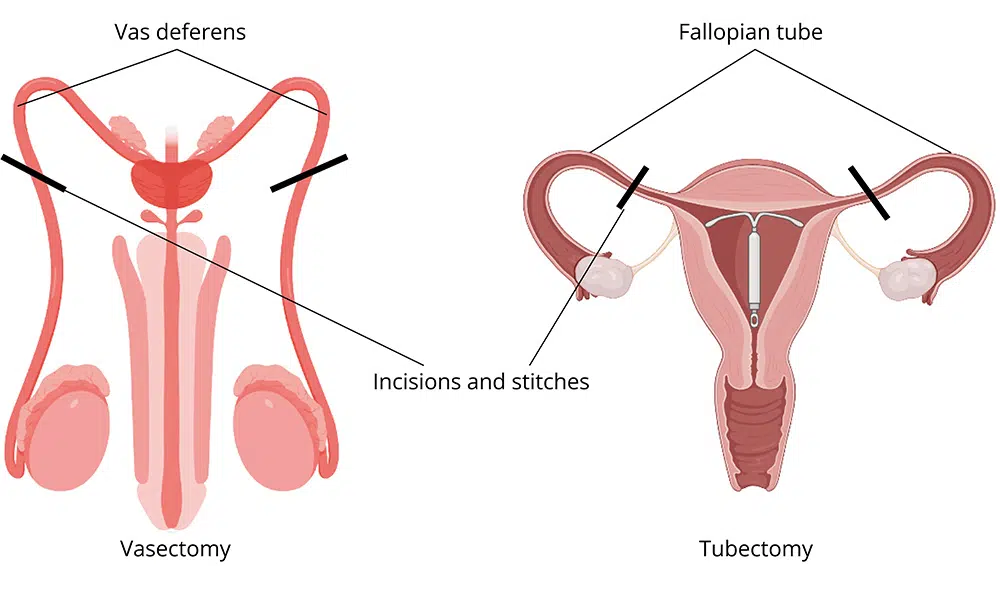Last updated on June 19, 2025
When it comes to permanent birth control, two procedures typically come to mind: tubal ligation for women and vasectomy for men. While both are highly effective forms of surgical sterilisation, they differ significantly in terms of procedure, recovery and risk.
For couples who are confident they’ve completed their families, choosing the right form of permanent contraception is a big decision. In this guide, we explore the key differences between tubal ligation vs vasectomy, how each procedure works and why more New Zealand couples are opting for vasectomy as their preferred long-term solution.
Understanding Permanent Birth Control
Permanent birth control refers to any medical procedure designed to prevent pregnancy for life. These options are generally considered only when an individual or couple is certain they no longer want to have children.
There are two primary types:
- Vasectomy – male sterilisation that involves blocking the tubes carrying sperm
- Tubal ligation – female sterilisation that involves sealing or removing the fallopian tubes
Both are intended to be permanent. While reversal procedures exist, they are not guaranteed and are often costly.
Vasectomy Explained
A vasectomy procedure is a form of male sterilisation where the vas deferens — the tubes that transport sperm — are sealed off. This prevents sperm from mixing with semen during ejaculation, eliminating the possibility of fertilisation.
At The Cooper Clinic, we offer a modern, no-scalpel vasectomy that is:
- Performed under local anaesthetic
- Minimally invasive and completed in under 30 minutes
- A walk-in, walk-out procedure with minimal recovery
- Highly effective, with success rates exceeding 99%
Unlike older techniques, the no-scalpel approach avoids the need for stitches and reduces the risk of bleeding or infection. Most men return to non-strenuous activities within 48 hours.

Tubal ligation vs vasectomy – understanding the key differences in permanent contraception methods for couples.
Tubal Ligation Explained
A tubal ligation procedure involves sealing, cutting, or removing the fallopian tubes, preventing the egg from reaching the uterus. It is a more complex form of female sterilisation that:
- Requires a hospital setting
- Involves general anaesthesia
- Is typically performed laparoscopically (keyhole surgery)
Recovery can take 1 to 2 weeks and although it is equally effective in preventing pregnancy, it carries a higher risk profile due to the nature of abdominal surgery. As with vasectomy, it should be considered a permanent contraception option.
Side-by-Side Comparison: Tubal Ligation vs Vasectomy
| Criteria | Vasectomy | Tubal Ligation |
|---|---|---|
| Type | Male sterilisation | Female sterilisation |
| Anaesthetic | Local anaesthetic | General anaesthetic |
| Procedure Time | Less than 20 minutes | Around 1 hour |
| Recovery Time | 2–3 days | 1–2 weeks |
| Setting | Outpatient clinic | Hospital surgical theatre |
| Reversibility | Sometimes possible | Rarely successful |
| Risks | Minimal | Higher due to general anaesthetic and internal organs |
| Complications | Rare; mild swelling, bruising, or short-term discomfort | May include internal bleeding, organ injury, or adverse reaction to anaesthesia |
| Cost | Typically lower | Usually 5 to 6 times more than vasectomy |
Factors to Consider When Choosing
Choosing between vasectomy and tubal ligation depends on several personal and medical factors:
- Age and health status
- Previous pregnancies or complications
- Comfort with surgical procedures
- Personal beliefs and preferences
- Willingness of each partner to undergo a procedure
For many couples, vasectomy presents a simpler, safer alternative — particularly when the female partner has health conditions that make surgery more risky.
Trends in New Zealand: What Are People Choosing?
In New Zealand, vasectomy is increasingly viewed as the more practical and accessible option for permanent birth control. While female sterilisation surgery is still available, it is less commonly performed, often requiring hospital admission, anaesthetists and a longer recovery.
Meanwhile, vasectomy procedures — especially those using the no-scalpel technique — are commonly performed in clinics like The Cooper Clinic, making them easier to access, less costly and faster to recover from.
Why Vasectomy Is Often the Preferred Option
There are several reasons why vasectomy is becoming the preferred choice for permanent contraception:
- Less invasive: No general anaesthesia, no abdominal incisions
- Lower risk: Fewer, less severe complications and minimal downtime
- More cost-effective: Typically much cheaper than tubal ligation
- Much Quicker recovery: Most men return to daily activities within days
- Highly effective: Offers permanent protection with minimal disruption
At The Cooper Clinic, we specialise exclusively in no-scalpel vasectomy, delivering a smooth, discreet and professional experience. Our procedures are performed in a relaxed outpatient setting, with full aftercare support and no hospital admission required.
Conclusion
Both tubal ligation and vasectomy are effective ways to achieve permanent birth control. However, for many couples, vasectomy provides a faster, safer and more affordable solution with fewer demands on the body and healthcare system. If you and your partner are considering long-term contraception, a vasectomy at The Cooper Clinic offers peace of mind with minimal fuss.
How to book a vasectomy appointment
- Fill out our online booking form
- Call us: 0800 884 408
- Email us: info@thecooperclinic.co.nz
Frequently Asked Questions
Is tubal ligation more effective than vasectomy?
Both procedures are over 99% effective at preventing pregnancy. However, vasectomy typically has a slightly lower risk of failure and fewer complications due to its simpler, non-invasive nature.
How long does it take to recover from a vasectomy?
Recovery from a no-scalpel vasectomy is usually quick, with most men resuming light activities within 1 to 2 days. Full recovery typically takes about a week, depending on individual healing.
Can a vasectomy be reversed?
Yes, vasectomy reversal is possible but not guaranteed and it involves a more complex surgical procedure. For this reason, vasectomy should be considered a permanent option.
Is tubal ligation permanent?
Tubal ligation is intended to be permanent and is rarely reversible. While reversal surgery exists, it is complex, expensive and not always successful.
What’s the difference between male and female sterilisation?
Male sterilisation (vasectomy) is a quick, outpatient procedure under local anaesthetic, while female sterilisation (tubal ligation) requires general anaesthetic and surgery. Vasectomy is generally lower risk, less costly and easier to access.







